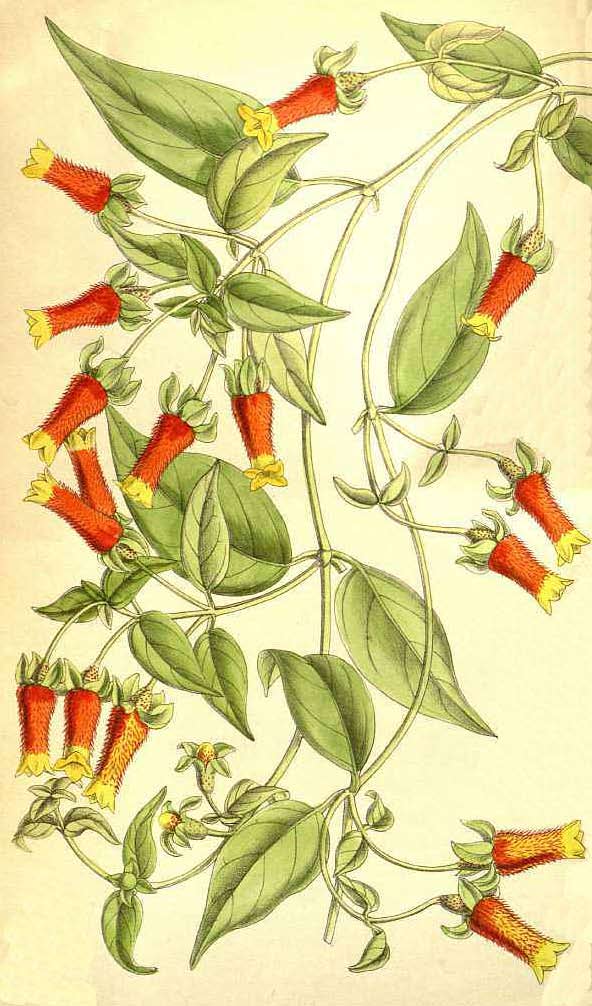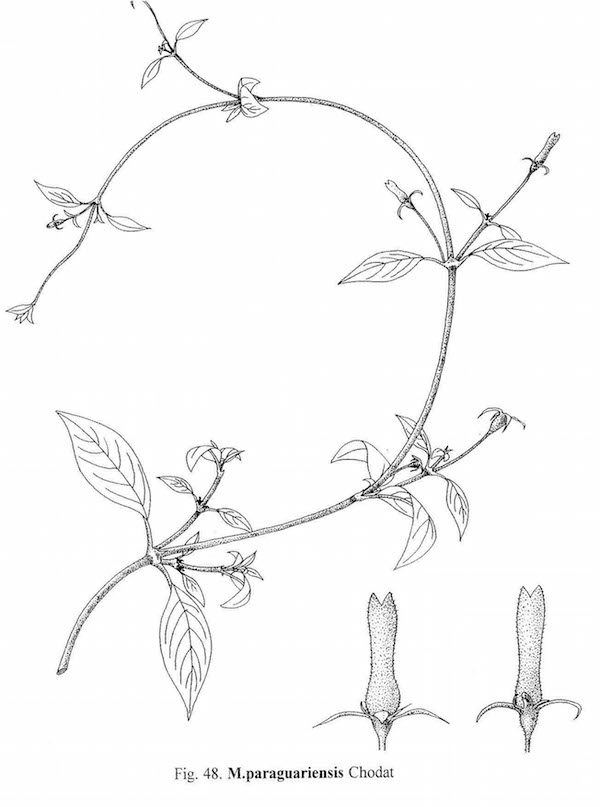My plants featured this month lack unambiguous English names. Yes, the English name Firecracker Vine has been applied to Manettia species since at least the 1940s. But it also more recently has been applied to at least three other plants, such as:
|
| Ipomoea lobata |
| Lonicera sempervirens |
Pyrostegia venusta
|
| These plants all have showy slender red flowers that account for the names. Variations for the Manettia species include Brazilian Firecracker (since 1958 or earlier) and Twining Firecracker (since 1957 or earlier). |
The English name Firecracker Plant is also applied to Manettia species, but it has been applied mostly to other plants, such as:
|
| Crossandra infundibuliformis |
| Crossandra nilotica |
| Cuphea ignea |
| Dicliptera sericea = D. suberecta |
| Echeveria setosa |
Russelia equisetiformis
|
A more modern name (since 1967 or before) that refers to the Manettia flowers being both red and yellow is Candy-Corn Plant. But again, that cute name is applied also to at least the following plants:
|
| Cuphea Llavea = Cuphea micropetala |
| Cuphea Melvilla |
| Moullava spicata |
| Nematanthus fluminensis |
| Nematanthus Wettsteinii = Hypocyrta Wettsteinii |
Neomortonia nummularia = Hypocyrta nummularia
|
Finally, though the name Cigar Flower has been used for various Cuphea species since at least 1873, some websites apply it to Manettia species. If it is used, making it Candy-Corn Vine, helps minimize confusion.
|
Genus Manettia was established in 1771, named after Italian Saverio (Xaverio) Manetti (1723 - 1785). The plants are tropical American, with somewhere between 80 and 130 species. Several species, as noted below, are cultivated indoors in cool temperate climates. I have never cultivated any. A few people in the North grow them as summer annuals, letting frost kill them.
|
In this article, my focus is on those species in the wild ingested by people, and those species cultivated indoors as houseplants. Botanists tend to disagree among themselves; some "lump" while others "split" species. The taxonomy I follow in this article is based on Estudos taxonômicos do gênero Manettia Mutis ex L. (Rubiaceae) no Brasil, Paraguai, Argentina e Uruguai [A taxonomic study of the genus Manettia Mutis ex L. (Rubiaceae) of Brazil, Paraguay, Argentina and Uruguay] a 350+ page doctoral thesis by Leila de Fátima Nogueira Macias 1998. The author did a thorough study, and I have no reason to presume to disagree with her findings. If you do a library or internet search, however, you will find that nearly all authors use confusing and contradicting nomenclature, compared to what Dr. Macias --and my article-- use.
|
| Manettia cordifolia Mart. |
| = M. glabra Cham. & Schltdl. |
This species is grown outdoors in the southern United States. Possibly a few people in cold areas containerize it and overwinter it indoors. It has widest natural distribution of all Manettia species, occurring from Peru to Uruguay. The flowers are slender and red --without yellow. Some photographs on the internet show such plants mislabeled as Manettia luteorubra. People like that it attracts hummingbirds & butterflies.
|
| Manettia luteorubra (Vell.) Benth. |
| = M. bicolor Paxton 1843, non Hook. fil. 1901 |
| = M. inflata hort., p.p., non Sprague |
The best known and most commonly cultivated species. Native in SE Brazil, mostly north of the closely related Manettia paraguariensis. Its flowers are red and yellow, with the yellow tip flaring outwards. The color drawing reproduced below is by M. Smith in Curtis's Botanical Magazine vol. 127 (1901). The foliage should be a darker green than shown.
|
| Manettia paraguariensis Chodat |
| = M. luteorubra var. paraguariensis (Chodat) I.C. Chung |
| = M. bicolor Hook. fil. 1901, non Paxton 1843 |
| = M. inflata Sprague |
From SE Brazil, SE Paraguay, and extreme NE Argentina. Similar to Manettia luteorubra but cultivated far less commonly. Its flowers, more inflated at the bottom, do not flare out at the yellow end; its sepals are slender, not broad. I reproduce below the black & white drawing from the thesis of Dr. Macias. A Portuguese name is Fruto-de-papagaio (Fruit-of-parrot). In the Guarani communities of Misiones Province, Argentina, parents give to their children the flowers --colorful tubes loaded with sweet fluid nectar-- teaching the kids to "suck" the nectar as if they were smoking a cigarette.
|
Other than the forgoing, human ingestion of Manettia species is likely limited to usage in the act of teeth blackening. Mostly in N Peru, Ecuador and adjacent Colombia and Brazil, about 40 different species belonging to 12 plant genera were or are used for the practice in different ethnolinguistic groups. Some ethnobotanists describe this practice in terms of oral hygiene --it reduces caries. Certainly, but it is far more involved, as you can read about in: "Cutting Old Life into New": Teeth Blackening in Western Amazonia by Thomas J. Zumbroich & Brian Stross in Anthropos 108: 53 - 75 (2013). Manettia species used in teeth blackening include at least the following four:
|
| Manettia coccinea (Aubl.) Willd. |
| Manettia divaricata Wernham |
| Manettia glandulosa L. |
Manettia reclinata Mart.
|
Teeth blackening was typically accomplished by chewing the leaves or other parts of one or more plants, often right after meals. Here is one account: "All women of this region chew the leaves to prevent tooth decay. Apparently there is something in the leaves which retards or stops fermentation. The use of this plant results in the blackened teeth characteristic of Jívaro women. The plant has no outstanding flavor; one might say much like almost any neutral flavored plant, but with just a tiny trace of bitterness, this after prolonged chewing." [Ethnobotanical Field Notes from Ecuador: Camp, Prieto, Jørgensen, and Giler by Elaine Joyal in Economic Botany 41(2): 163 - 189 (1987).]
|
If and when I obtain a Manettia houseplant, I shall taste its leaves, and suck nectar from its flowers. Manettia are not included in references on toxic plants, so I have no concerns about sampling them. If that happens, I shall update this article for you.
Back |

Manettia luteorubra by M. Smith in Curtis's Botanical Magazine vol. 127 (1901)
|

Manettia paraguariensis from Estudos taxonômicos do gênero Manettia Mutis ex L. (Rubiaceae) no Brasil, Paraguai, Argentina e Uruguai by Leila de Fátima Nogueira Macias (1998)
|

